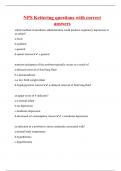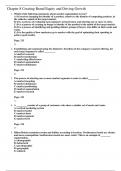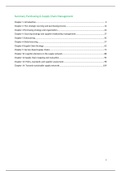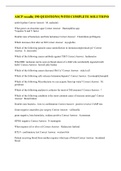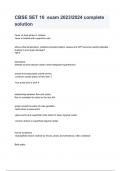TENTAMENVOORBEREIDING – Qualitative Methods
Inhoud
Chapter 1 – Introduction to Qualitative Methods.....................................................................5
Learning objectives.............................................................................................................. 5
Definition of Qualitative Research Methods.........................................................................5
Most common methods.......................................................................................................5
The context and characteristics of QRM (V)........................................................................6
Qualitative Research Methods?.......................................................................................6
Why are Qualitative Research Methods becoming more important?................................6
Qualitative researcher needs…........................................................................................6
Validity and Reliability......................................................................................................6
Critique on validity and reliability in QRM.........................................................................7
Key terms............................................................................................................................ 7
Chapter 2 – Theoretical Background for Course.....................................................................8
Learning objectives.............................................................................................................. 8
Philosophical Roots and Historical Development (V)...........................................................8
Philosophy of Science......................................................................................................8
Positivism (Comte, 1798-1857)........................................................................................8
Phenomenological ideas (Husserl, 1859-1938)................................................................8
Interpretative Approach..................................................................................................10
Historical development...................................................................................................10
Philosophical assumptions.................................................................................................10
Interpretative frameworks (V).............................................................................................10
Post-positivism............................................................................................................... 10
Social Constructivism.....................................................................................................11
Post-structuralism.......................................................................................................... 11
Transformative Frameworks...........................................................................................11
Common Ground............................................................................................................12
Three Theoretical Approaches (V).....................................................................................12
Symbolic interactionism..................................................................................................12
Ethnomethodology......................................................................................................... 12
Post-structuralist theorizing............................................................................................13
Common ground:...........................................................................................................13
Which qualitative approach best fits?.................................................................................13
Narrative research.............................................................................................................14
Definition........................................................................................................................ 14
Core elements of narrative research..............................................................................14
Approaches to Narrative research:.................................................................................14
1
, Procedure...................................................................................................................... 15
Challenges..................................................................................................................... 15
Phenomenological research..............................................................................................15
Definition........................................................................................................................ 15
Four philosophical perspectives in phenomenological research:....................................15
Core Elements of phenomenological research...............................................................16
Approaches to Phenomenology.....................................................................................16
Procedure...................................................................................................................... 17
Challenges..................................................................................................................... 17
Grounded Theory...............................................................................................................17
Definition........................................................................................................................ 17
Background....................................................................................................................17
Core elements of grounded theory.................................................................................17
Procedure...................................................................................................................... 17
Challenges..................................................................................................................... 17
Ethnography...................................................................................................................... 18
Definition........................................................................................................................ 18
Core elements of ethnography.......................................................................................18
Approaches to ethnography...........................................................................................18
Procedure...................................................................................................................... 18
Critical Discourse Analysis.................................................................................................18
Definition........................................................................................................................ 18
Background....................................................................................................................18
Approaches to Discourse Analysis.................................................................................19
Core elements................................................................................................................ 19
Procedure...................................................................................................................... 19
Comparison – Qualitative Research Approaches..............................................................20
Key terms – Chapter 2.......................................................................................................20
Chapter 3 – Research Design for Qualitative Research........................................................20
Learning objectives............................................................................................................20
Bottom-up approach..........................................................................................................20
The ‘Hidden Truth’ about Research Design.......................................................................21
Presenting and Justifying your Qualitative Research.........................................................21
How to make your Research Design Stand Out.................................................................21
Research ethics (V)...........................................................................................................21
Informed consent...............................................................................................................22
Organizational or institutional level.................................................................................22
Community informed consent.........................................................................................22
Individual consent.......................................................................................................... 23
2
, Quality Criteria for Qualitative Research............................................................................23
Choosing the right Research Methods (V).........................................................................24
When to use semi-structured interviews (V)......................................................................24
When to use narrative interviews (V).................................................................................24
When to use focus groups (V)...........................................................................................24
When to use participant observation (V)............................................................................25
When to use discourse analysis (V)...................................................................................25
Mixed Methods Research Design (V)................................................................................25
Case Study Research Design (V)......................................................................................26
Key terms of Chapter 3......................................................................................................27
Chapter 4 – Collecting Qualitative Data.................................................................................27
Learning objectives............................................................................................................27
Preparing your (semi-structured) interview (V)...................................................................27
Conducting the interview (V)..............................................................................................28
Transcribing the interview..................................................................................................28
Key terms of chapter 4.1....................................................................................................28
Introduction to Observation (V)..........................................................................................30
Participant observation (V).................................................................................................30
Taking notes when conducting (participant) observations..................................................31
Limitations of participant observation.................................................................................31
Structured observation.......................................................................................................31
Internet-Mediated Observations.........................................................................................33
Videography...................................................................................................................... 33
Key terms of chapter 4.3....................................................................................................33
Observation analysis (V)....................................................................................................33
Chapter 5 – Analyzing Qualitative Data.................................................................................34
Learning objectives............................................................................................................34
Introduction to Atlas.ti........................................................................................................34
Grounded theory analysis (V)............................................................................................34
Constructivist Grounded Theory Analysis..........................................................................34
Challenges in Grounded Theory Analysis..........................................................................35
Key terms of chapter 5.2 (GTA).........................................................................................35
The Origins of Discourse Theory.......................................................................................35
Structuralism..................................................................................................................35
Critiques on structuralism and poststructuralism............................................................35
Fundamentals of (critical) discourse analysis (V)...............................................................37
How to perform critical discourse analysis (V)...................................................................37
Key terms of chapter 5.3....................................................................................................38
Phenomenological analysis...............................................................................................38
3
, Hermeneutic circle.........................................................................................................38
Step-by-step procedure for phenomenological analysis.....................................................38
What is a “theme”?............................................................................................................ 40
Limitations of Interpretative Phenomenological Analysis (Heidegger)................................40
Key terms of chapter 5.4....................................................................................................40
Characterization of Ethnographic analysis.........................................................................40
Key term of chapter 5.5.....................................................................................................41
Foundations of Visual Data Analysis..................................................................................41
Characteristics of Visual Data Analysis..............................................................................41
Key terms of chapter 5.6....................................................................................................42
Chapter 6 – Reporting Results of Qualitative Research........................................................43
Learning objectives............................................................................................................43
Key considerations when reporting results........................................................................43
Different voices for reporting results...............................................................................43
Title................................................................................................................................ 43
Preface........................................................................................................................... 43
Introduction.................................................................................................................... 43
Theory section................................................................................................................ 44
Methodology section......................................................................................................44
Results section...............................................................................................................44
Use of quotes.................................................................................................................44
Conclusions................................................................................................................... 45
Revisiting Ethical Considerations.......................................................................................45
The Importance of Reflexivity............................................................................................45
Writing structures...............................................................................................................45
Narrative writing structures.............................................................................................46
Phenomenological writing structures..............................................................................46
Grounded theory writing structures................................................................................46
Ethnographic writing structures......................................................................................47
(Critical) Discourse Analysis writing structures...............................................................47
Key terms of chapter 6.1....................................................................................................48
4
,Chapter 1 – Introduction to Qualitative Methods
Learning objectives
- Characterise Qualitative Research Methods (QRM);
- Describe different periods of the development of QRM;
- Name different current societal trends which make QRM all the more relevant;
- Differentiate QRM from Quantitative Research Methods;
- Define quality criteria for sound Qualitative Research;
- Determine for which kind of research questions Qualitative Research Methods would
be specifically suitable;
- Underpin your choice for specific Qualitative Methods.
Definition of Qualitative Research Methods
Qualitative research begins with:
- Assumptions;
- The use of interpretive/theoretical frameworks;
- A study of research problems addressing the meaning individuals or groups ascribe
to a social or human problem.
To study this problem:
- Use an emerging qualitative approach to inquiry;
- The collection of data in a natural setting sensitive to the people and places under
study;
- Data analysis that is both inductive and deductive and establishes patterns or
themes.
The final written report or presentation includes:
- The voices of participants;
- The reflexivity of a researcher;
- A complex description and interpretation of a problem;
- Contribution to the literature or a call for change.
Most common methods
- Case studies;
o A process of research into the development of a particular person/group
over a period of time.
- Grounded Theory;
o The analysis and development of theories happens after you have collected
the data (Glaser & Strauss).
- Phenomenology;
o An approach that concentrates on the study of consciousness and the objects
of direct experience.
- Discourse analysis;
o This research method focuses on interaction, looking beyond the literal
meaning of language.
- Ethnography;
o The scientific description of peoples and cultures with their customs habits,
and mutual differences.
- Visual Data Analysis.
o The use of sophisticated tools and processes to analyze datasets using visual
representations of data (graphs, charts, and maps).
5
, The context and characteristics of QRM (V)
Qualitative Research Methods?
- In-depth (contextual) understanding of human actions;
- It investigates the why and how of our actions;
- Smaller, but focused samples;
- ‘Context’ plays an important role:
o ‘Human actions mean different things to different people in different places’.
- No general and universal laws which govern human actions;
- We need to understand each case in its own right.
o To understand socio-spatial actions we need to be open to the specificity of
the context and to the individuality of their interpretations.
o Generalized/Standardized data and categorizations often miss these
contextualities, spatialities and individualities.
Why are Qualitative Research Methods becoming more important?
- Pluralization of life-worlds;
- Development of (post-)modern social sciences;
- Disenchantment of ideal of scientific objectivity.
Qualitative research is the study of reasons, meaning and sense behind human actions.
Seeks to answer WHY people practice certain human actions, whilst quantitative research
seeks to answer HOW MANY people via a survey.
Qualitative researcher needs…
- Commitment to spend extensive time in the
field;
- Engagement in the complex, time-consuming
task of data analysis;
- A commitment to writing long passages
showing multiple perspectives the complexity
of findings;
- Participation in a process that does not have
firm guidelines or specific procedures and is
constantly evolving and changing.
Validity and Reliability
Validity:
- Internal & construct validity:
o Are inferences correct?
o Do data reflect reality?
o Meet ik wat ik wil meten?
- External validity:
o Generalisability: can we develop a general theory?
o Generaliseerbaarheid?
Reliability:
- Are observations independent of (biases or mistakes by) the researcher?
- Are observations replicable?
6
Inhoud
Chapter 1 – Introduction to Qualitative Methods.....................................................................5
Learning objectives.............................................................................................................. 5
Definition of Qualitative Research Methods.........................................................................5
Most common methods.......................................................................................................5
The context and characteristics of QRM (V)........................................................................6
Qualitative Research Methods?.......................................................................................6
Why are Qualitative Research Methods becoming more important?................................6
Qualitative researcher needs…........................................................................................6
Validity and Reliability......................................................................................................6
Critique on validity and reliability in QRM.........................................................................7
Key terms............................................................................................................................ 7
Chapter 2 – Theoretical Background for Course.....................................................................8
Learning objectives.............................................................................................................. 8
Philosophical Roots and Historical Development (V)...........................................................8
Philosophy of Science......................................................................................................8
Positivism (Comte, 1798-1857)........................................................................................8
Phenomenological ideas (Husserl, 1859-1938)................................................................8
Interpretative Approach..................................................................................................10
Historical development...................................................................................................10
Philosophical assumptions.................................................................................................10
Interpretative frameworks (V).............................................................................................10
Post-positivism............................................................................................................... 10
Social Constructivism.....................................................................................................11
Post-structuralism.......................................................................................................... 11
Transformative Frameworks...........................................................................................11
Common Ground............................................................................................................12
Three Theoretical Approaches (V).....................................................................................12
Symbolic interactionism..................................................................................................12
Ethnomethodology......................................................................................................... 12
Post-structuralist theorizing............................................................................................13
Common ground:...........................................................................................................13
Which qualitative approach best fits?.................................................................................13
Narrative research.............................................................................................................14
Definition........................................................................................................................ 14
Core elements of narrative research..............................................................................14
Approaches to Narrative research:.................................................................................14
1
, Procedure...................................................................................................................... 15
Challenges..................................................................................................................... 15
Phenomenological research..............................................................................................15
Definition........................................................................................................................ 15
Four philosophical perspectives in phenomenological research:....................................15
Core Elements of phenomenological research...............................................................16
Approaches to Phenomenology.....................................................................................16
Procedure...................................................................................................................... 17
Challenges..................................................................................................................... 17
Grounded Theory...............................................................................................................17
Definition........................................................................................................................ 17
Background....................................................................................................................17
Core elements of grounded theory.................................................................................17
Procedure...................................................................................................................... 17
Challenges..................................................................................................................... 17
Ethnography...................................................................................................................... 18
Definition........................................................................................................................ 18
Core elements of ethnography.......................................................................................18
Approaches to ethnography...........................................................................................18
Procedure...................................................................................................................... 18
Critical Discourse Analysis.................................................................................................18
Definition........................................................................................................................ 18
Background....................................................................................................................18
Approaches to Discourse Analysis.................................................................................19
Core elements................................................................................................................ 19
Procedure...................................................................................................................... 19
Comparison – Qualitative Research Approaches..............................................................20
Key terms – Chapter 2.......................................................................................................20
Chapter 3 – Research Design for Qualitative Research........................................................20
Learning objectives............................................................................................................20
Bottom-up approach..........................................................................................................20
The ‘Hidden Truth’ about Research Design.......................................................................21
Presenting and Justifying your Qualitative Research.........................................................21
How to make your Research Design Stand Out.................................................................21
Research ethics (V)...........................................................................................................21
Informed consent...............................................................................................................22
Organizational or institutional level.................................................................................22
Community informed consent.........................................................................................22
Individual consent.......................................................................................................... 23
2
, Quality Criteria for Qualitative Research............................................................................23
Choosing the right Research Methods (V).........................................................................24
When to use semi-structured interviews (V)......................................................................24
When to use narrative interviews (V).................................................................................24
When to use focus groups (V)...........................................................................................24
When to use participant observation (V)............................................................................25
When to use discourse analysis (V)...................................................................................25
Mixed Methods Research Design (V)................................................................................25
Case Study Research Design (V)......................................................................................26
Key terms of Chapter 3......................................................................................................27
Chapter 4 – Collecting Qualitative Data.................................................................................27
Learning objectives............................................................................................................27
Preparing your (semi-structured) interview (V)...................................................................27
Conducting the interview (V)..............................................................................................28
Transcribing the interview..................................................................................................28
Key terms of chapter 4.1....................................................................................................28
Introduction to Observation (V)..........................................................................................30
Participant observation (V).................................................................................................30
Taking notes when conducting (participant) observations..................................................31
Limitations of participant observation.................................................................................31
Structured observation.......................................................................................................31
Internet-Mediated Observations.........................................................................................33
Videography...................................................................................................................... 33
Key terms of chapter 4.3....................................................................................................33
Observation analysis (V)....................................................................................................33
Chapter 5 – Analyzing Qualitative Data.................................................................................34
Learning objectives............................................................................................................34
Introduction to Atlas.ti........................................................................................................34
Grounded theory analysis (V)............................................................................................34
Constructivist Grounded Theory Analysis..........................................................................34
Challenges in Grounded Theory Analysis..........................................................................35
Key terms of chapter 5.2 (GTA).........................................................................................35
The Origins of Discourse Theory.......................................................................................35
Structuralism..................................................................................................................35
Critiques on structuralism and poststructuralism............................................................35
Fundamentals of (critical) discourse analysis (V)...............................................................37
How to perform critical discourse analysis (V)...................................................................37
Key terms of chapter 5.3....................................................................................................38
Phenomenological analysis...............................................................................................38
3
, Hermeneutic circle.........................................................................................................38
Step-by-step procedure for phenomenological analysis.....................................................38
What is a “theme”?............................................................................................................ 40
Limitations of Interpretative Phenomenological Analysis (Heidegger)................................40
Key terms of chapter 5.4....................................................................................................40
Characterization of Ethnographic analysis.........................................................................40
Key term of chapter 5.5.....................................................................................................41
Foundations of Visual Data Analysis..................................................................................41
Characteristics of Visual Data Analysis..............................................................................41
Key terms of chapter 5.6....................................................................................................42
Chapter 6 – Reporting Results of Qualitative Research........................................................43
Learning objectives............................................................................................................43
Key considerations when reporting results........................................................................43
Different voices for reporting results...............................................................................43
Title................................................................................................................................ 43
Preface........................................................................................................................... 43
Introduction.................................................................................................................... 43
Theory section................................................................................................................ 44
Methodology section......................................................................................................44
Results section...............................................................................................................44
Use of quotes.................................................................................................................44
Conclusions................................................................................................................... 45
Revisiting Ethical Considerations.......................................................................................45
The Importance of Reflexivity............................................................................................45
Writing structures...............................................................................................................45
Narrative writing structures.............................................................................................46
Phenomenological writing structures..............................................................................46
Grounded theory writing structures................................................................................46
Ethnographic writing structures......................................................................................47
(Critical) Discourse Analysis writing structures...............................................................47
Key terms of chapter 6.1....................................................................................................48
4
,Chapter 1 – Introduction to Qualitative Methods
Learning objectives
- Characterise Qualitative Research Methods (QRM);
- Describe different periods of the development of QRM;
- Name different current societal trends which make QRM all the more relevant;
- Differentiate QRM from Quantitative Research Methods;
- Define quality criteria for sound Qualitative Research;
- Determine for which kind of research questions Qualitative Research Methods would
be specifically suitable;
- Underpin your choice for specific Qualitative Methods.
Definition of Qualitative Research Methods
Qualitative research begins with:
- Assumptions;
- The use of interpretive/theoretical frameworks;
- A study of research problems addressing the meaning individuals or groups ascribe
to a social or human problem.
To study this problem:
- Use an emerging qualitative approach to inquiry;
- The collection of data in a natural setting sensitive to the people and places under
study;
- Data analysis that is both inductive and deductive and establishes patterns or
themes.
The final written report or presentation includes:
- The voices of participants;
- The reflexivity of a researcher;
- A complex description and interpretation of a problem;
- Contribution to the literature or a call for change.
Most common methods
- Case studies;
o A process of research into the development of a particular person/group
over a period of time.
- Grounded Theory;
o The analysis and development of theories happens after you have collected
the data (Glaser & Strauss).
- Phenomenology;
o An approach that concentrates on the study of consciousness and the objects
of direct experience.
- Discourse analysis;
o This research method focuses on interaction, looking beyond the literal
meaning of language.
- Ethnography;
o The scientific description of peoples and cultures with their customs habits,
and mutual differences.
- Visual Data Analysis.
o The use of sophisticated tools and processes to analyze datasets using visual
representations of data (graphs, charts, and maps).
5
, The context and characteristics of QRM (V)
Qualitative Research Methods?
- In-depth (contextual) understanding of human actions;
- It investigates the why and how of our actions;
- Smaller, but focused samples;
- ‘Context’ plays an important role:
o ‘Human actions mean different things to different people in different places’.
- No general and universal laws which govern human actions;
- We need to understand each case in its own right.
o To understand socio-spatial actions we need to be open to the specificity of
the context and to the individuality of their interpretations.
o Generalized/Standardized data and categorizations often miss these
contextualities, spatialities and individualities.
Why are Qualitative Research Methods becoming more important?
- Pluralization of life-worlds;
- Development of (post-)modern social sciences;
- Disenchantment of ideal of scientific objectivity.
Qualitative research is the study of reasons, meaning and sense behind human actions.
Seeks to answer WHY people practice certain human actions, whilst quantitative research
seeks to answer HOW MANY people via a survey.
Qualitative researcher needs…
- Commitment to spend extensive time in the
field;
- Engagement in the complex, time-consuming
task of data analysis;
- A commitment to writing long passages
showing multiple perspectives the complexity
of findings;
- Participation in a process that does not have
firm guidelines or specific procedures and is
constantly evolving and changing.
Validity and Reliability
Validity:
- Internal & construct validity:
o Are inferences correct?
o Do data reflect reality?
o Meet ik wat ik wil meten?
- External validity:
o Generalisability: can we develop a general theory?
o Generaliseerbaarheid?
Reliability:
- Are observations independent of (biases or mistakes by) the researcher?
- Are observations replicable?
6


